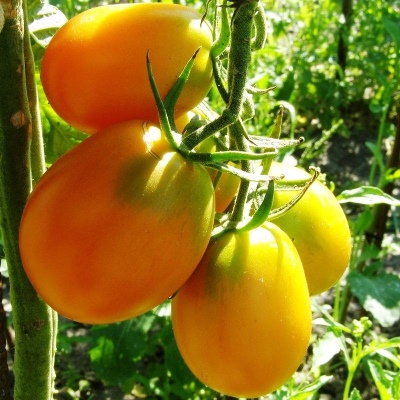
- Authors: Andreeva Evgeniya Nikolaevna, Sysina Elena Artemyevna, Nazina Sofia Luisovna, Bogdanov Kirill Borisovich, "GISOK" Selection and Seed Company "
- Year of approval: 1998
- Category: grade
- Growth type: indeterminate
- Appointment: fresh consumption, for whole fruit preservation
- Ripening period: mid-season
- Ripening time, days: 120
- Growing conditions: for film greenhouses
- Marketability: high
- Transportability: good
De Barao golden is one of the universal indeterminate varieties suitable for canning and fresh consumption. Tomatoes are grown outdoors and in all types of greenhouses. The fruits are highly decorative, marketable, and transportable.
Breeding history
The variety was approved for use in 1998. The originators are E. N. Andreeva, E. A. Sysina, S. L. Nazina, K. B. Bogdanov - breeders of OOO GISOK Seed Breeding Company.
Description of the variety
Tall, highly branched bushes (from 200 cm) are covered with dense dark green foliage with an average degree of corrugation.
Features and benefits of the variety:
- ripening ability;
- presentation and sufficient keeping quality;
- shade tolerance, elongation of fruiting;
- unpretentiousness, productivity, versatility, strong immunity.
If we talk about the shortcomings, then there are few of them:
- the bush requires free space;
- compulsory pinching and shaping;
- the tomato needs serious support or a stable trellis.
Yellow flowers are collected in simple inflorescences, the first of which is laid over 9-11 leaves, all subsequent ones - through 3 cuttings.
The main qualities of the fruit
Small (79–83 g) oval fruits have a small depression at the base. Tomatoes, green in an unripe state, as they ripen, acquire a beautiful rich yellow, sometimes lemon hue. The fruit has two seed chambers with few seeds. The dry matter content is about 5%.
Taste characteristics
Sweet, with a noticeable pleasant sourness, juicy pulp is covered with a dense glossy smooth skin, which makes the fruits of the variety suitable for long-term storage and transportation.
Ripening and fruiting
De Barao gold belongs to the middle-ripening category, the stated ripening period is 120 days. Harvesting begins in August - September.
Yield
The high-yielding variety gives 6.2–6.4 kg per square meter and 4–5 kg per bush, but this is not the limit - good agricultural technology can significantly increase performance.
The timing of planting seedlings and planting in the ground
Any kind of De Barao is grown in seedlings, sowing seeds on March 1-15 and planting ready-made seedlings in a greenhouse in early - mid-May, and in a vegetable garden - in May - June. More precise terms depend on the microclimate of a particular area. Even in one district or region, it can vary greatly. For example, the Krasnoyarsk Territory, where the conditions for tomatoes are rather harsh. At the same time, the Minusinsk Hollow and the city of Minusinsk are called tomato paradise, where many delicious varieties are bred. Tomatoes are planted there much earlier than in other parts of the region.

Growing tomato seedlings is an extremely important process, because it largely depends on whether the gardener will be able to harvest at all. All aspects must be taken into account, from seedbed preparation to planting in the ground.
Landing scheme
The most optimal planting scheme for such powerful plants is 40x60 cm, no more than two roots per square meter.

Growing and care
The unpretentiousness of the plant allows it to be planted not only in greenhouses, but also in open ground, even in the Urals, Siberia and the Far East. However, greenhouses in cold regions enable the variety to more fully reveal its fruiting potential.
Seedlings are grown in the traditional way, like other varieties. Before planting in a permanent place, young plants are hardened, accustoming them to ambient temperature and natural light.
The soil for tomatoes should have a neutral acidity level. Acidified soil is deoxidized with bone and dolomite flour, chalk, lime, gypsum.
Organic matter is introduced into the soil during the autumn digging, it is desirable that it be manure - during the winter it will grind, acquire the desired condition. In the spring, organic matter is introduced in the form of compost, humus, bird droppings, complex mineral fertilizers for tomatoes and wood ash are added. Stakes are installed in the holes for future support, if a trellis is not provided. Further care consists in watering, weeding, sanitizing.




A plant needs different micronutrients at each stage of growth. All fertilizers can be divided into two groups: mineral and organic. Folk remedies are often used: iodine, yeast, bird droppings, eggshells.
It is important to observe the rate and period of feeding. This also applies to folk remedies and organic fertilizers.
Disease and pest resistance
The tomato has good resistance to late blight, but is prone to top rot, and can also suffer from such pests as melon aphids, thrips, bear and slugs, the latter being the most dangerous for the plant. In order to protect De Barao from damage, preventive treatments with insecticides and fungicides should be used.


Resistant to adverse weather conditions
De Barao gold grows well and bears fruit with any method of cultivation in the southern regions. However, poor resistance to sudden temperature changes, cold snaps and rainy periods allows cultivation of the variety in cold regions only in greenhouse conditions.
Growing regions
The variety is adapted to the difficult climate of risky farming areas. These are the Northern, North-Western, Central, Volgo-Vyatka regions, as well as the Central Black Earth Region, the North Caucasian, Middle Volga, Lower Volga, Ural, West Siberian, East Siberian and Far Eastern regions.

























































































